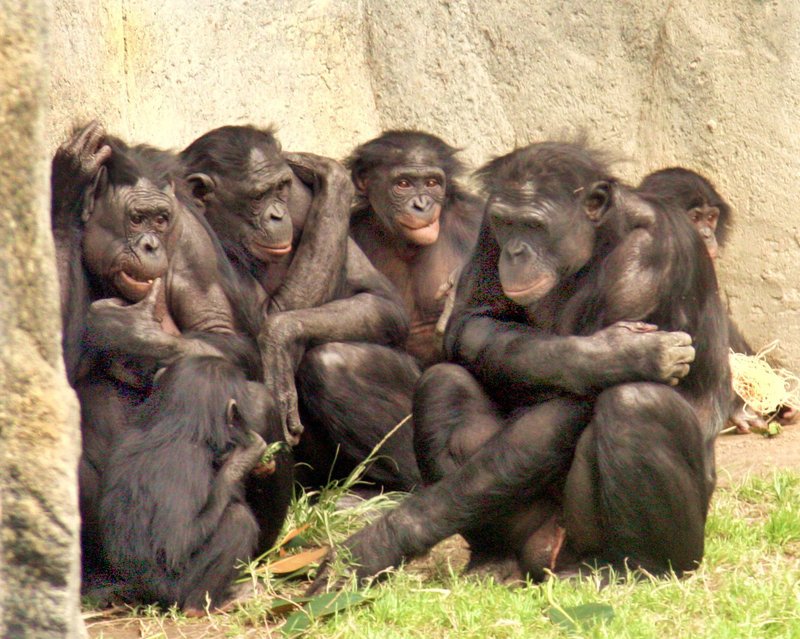
Just like stories of mermaids and dragons capture the imagination, tales about bonobos reflect our shared curiosity and connection with nature. The way bonobos navigate their social lives—filled with empathy, cooperation, and occasional mischief—offers rich material for storytelling. It’s almost like they’re nature’s way of showing us the balance between peace and conflict. Let’s dive into how bonobos are represented in culture and folklore, and I promise it’ll be more interesting than your average trip to the zoo.
The Bonobo’s Role in Cultural Narratives
In various cultures, animals often symbolize human traits or moral lessons. Bonobos, with their peaceful and cooperative nature, are frequently associated with themes of harmony and community. For instance, African folklore sometimes depicts bonobos as wise beings that help guide humans in resolving conflicts. This can be traced back to how they approach disputes among themselves—resolving differences through social bonding rather than aggression.
These stories often convey important messages about community living. Think of it like a village where everyone works together to create a safe and nurturing environment. In such narratives, bonobos might be portrayed as the peacemakers, reminding us of the importance of cooperation in our everyday lives. Children grow up hearing these tales, internalizing valuable lessons about teamwork and understanding.
Bonobos in Literature and Popular Media
You might be surprised to find bonobos showing up in books, films, and even cartoons. They’re not just background characters; often, they take center stage, symbolizing the complexities of human behavior. In literature, writers might use the bonobo as a metaphor for innate human qualities—like compassion or the drive to form social connections.
For example, some contemporary children’s books feature bonobos that teach kids about emotions and relationships. These stories often highlight how bonobos process feelings differently than humans, showcasing the beauty of emotional intelligence. It’s a gentle reminder that while we may be different, our core feelings and needs are quite similar. Plus, seeing a cute bonobo in a story is way more appealing than a grumpy old wolf, right?
Artistic Representations of Bonobos
Artists love to use animals to convey deeper meanings, and bonobos are no exception. You can find bonobos depicted in various art forms, from sculptures to paintings. Often, these artworks capture the social and affectionate behavior of bonobos, illustrating their playful nature and strong bonds.
Take, for example, a painting that shows a group of bonobos lounging together, sharing fruit. This image doesn’t just depict their daily life; it tells a story about community and nurturing relationships. It’s like a snapshot of their world, urging viewers to appreciate the importance of love and connection in their own lives. When artists create works featuring bonobos, they’re not just showcasing an animal; they’re inviting us to ponder our human nature.
Spiritual Connections with Bonobos
In some cultures, bonobos are considered spiritual symbols, embodying traits like peace and community. This reverence often stems from their unique social structures, which prioritize connection and empathy. In certain African traditions, bonobos are seen as a bridge between humanity and the spirit world, embodying the virtues people aspire to achieve.
The idea is similar to how some cultures view animals as totems or spirit guides. Bonobos, as gentle and cooperative creatures, inspire individuals to cultivate love and understanding in their lives. Imagine a community gathering where stories of bonobo adventures are shared, each tale reinforcing the values of compassion and unity. These moments help strengthen social ties, fostering a deeper connection to nature.
Bonobos in Scientific and Educational Contexts
The significance of bonobos extends beyond folklore and storytelling; they also play an essential role in scientific research and education. As one of our closest living relatives, studying bonobos can provide insights into human evolution and behavior. This connection makes them a popular subject in documentaries and educational programs, helping raise awareness about their plight and the need for conservation.
When schools teach children about bonobos, they often highlight their unique social structures and behaviors. By framing these discussions in the context of empathy, cooperation, and community, educators use bonobos as a tool to instill values in young minds. It’s more than just an animal lesson; it’s about understanding ourselves through the lens of another species.
Modern Perspectives and Conservation Efforts
In recent years, the conversation around bonobos has shifted toward conservation and protection. With their populations declining due to habitat loss and poaching, stories about bonobos are increasingly focused not just on their fascinating behaviors but also on the urgent need to protect them. Organizations and storytellers alike are raising awareness about the challenges bonobos face in the wild.
By sharing bonobo stories, advocates aim to inspire others to take action. You might see campaigns featuring bonobos that emphasize the importance of preserving their habitats. This modern narrative intertwines culture, conservation, and education, creating a holistic approach to understanding these incredible creatures.
Bonobos, with their unique social structures and peaceful demeanors, have woven themselves into the fabric of different cultures and folklore. From acting as symbols of cooperation to featuring in art and literature, bonobos invite us to reflect on the importance of community and understanding. As we learn about their struggles and the need for conservation, we become part of their story too.
Ultimately, bonobos remind us not just of our connection to the animal kingdom, but of the values—like empathy and cooperation—that can enrich our lives. So next time you hear about bonobos in stories or documentaries, remember that these gentle apes are more than just animals; they’re a bridge to understanding our own humanity.

